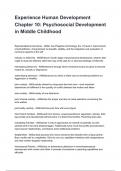Experience Human Development
Chapter 10: Psychosocial Development
in Middle Childhood
Representational structures - ANSin neo-Piagetian terminology, the 1/3 level in improvement
of self-definition, characterized via breadth, stability, and the integration and evaluation of
numerous aspects of the self
industry vs inferiority - ANSErikson's fourth stage of psychosocial development, wherein kids
ought to study the effective skills their way of life calls for or else face feelings of inferiority
internalizing behaviors - ANSbehaviors through which emotional issues are grew to become
inward ex. Anxiety or Depression
externalizing behaviors - ANSbehaviors by which a infant acts out emotional problems ex.
Aggression or Hostility
joint custody - ANScustody shared by using each dad and mom - most important
determinant of fulfillment is the quantity of conflict between the mother and father
sole custody - ANScustody of one determine
joint criminal custody - ANSshare the proper and duty to make selections concerning the
kid's welfare
joint bodily custody - ANSchild lives part time with every figure
One Parent Families - ANSresult from divorce, unwed parenthood, separation, demise. Kids
lag socially and educationally behind peers in 2 determine families. Parenting lacks also
Cohabiting Families - ANSsimilar in lots of approaches to married households, but the
parents tend to be extra disadvantaged. Traditionally have much less profits and education,
report poorer relationships, and feature extra intellectual problems
Stepfamilies - ANSunwed spouses who marry someone else besides their unique partner.
Boys modify well to a stepfather. Girls do now not, stepfather interferes with independence
and near mother-daughter relationship
Homosexual Parents - ANSshow no tremendous distinction in homo/heterosexual
development with mother and father in phrases of emotional or parenting capabilities and
attitudes
, open adoptions - ANSboth the organic parents and adoptive parents share facts or have
direct contact with the kid
Adoptive Families - ANSshow no sizeable variations among adoptive/non-adoptive
households
adversarial attribution bias - ANStendency to understand others as trying to hurt one and to
strike out in retaliation or self protection - reactive aggression
proactive (instrumental) aggressors - ANSkids that view force and coercion as effective
methods to get what they want
bullying - ANSaggression deliberately and persistently directed in opposition to a selected
target, or sufferer, usually one who's susceptible, vulnerable or defenseless - can be
proactive or reactive
disruptive behavior disorders - ANSaggression, defiance, or antisocial behavior
anxiety or mood disorders - ANSfeeling sad, depressed, unloved, fearful, nervous, or lonely
oppositional defiant disease (ODD) - ANSpattern of behavior, persisting into middle youth,
marked by using negativity, hostility, and defiance
behavior sickness (CD) - ANSrepetitive, continual pattern of aggressive, delinquent conduct
violating societal norms or the rights of others
college phobia - ANSunrealistic worry of going to school, can be a shape of separation
tension disease or social phobia
separation tension disease - ANScondition concerning excessive, prolonged tension
regarding separation from home or from people to whom someone is attached - decreases
with age
social phobia - ANSsocial anxiety - excessive fear and/or avoidance of social situations - will
increase with age
generalized tension disorder - ANSanxiety no longer focused on any unmarried target - kids
worry about the whole lot
obsessive-compulsive sickness (OCD) - ANSanxiety aroused by way of repetitive, intrusive
mind, pix, or impulses, often main to compulsive ritual behaviors
adolescence melancholy - ANSmood sickness characterised by such symptoms as
extended feel of friendlessness, incapability to have fun or pay attention, fatigue, excessive
hobby or apathy, emotions of worthlessness, weight trade, bodily lawsuits and mind of death
or suicide - it is an affective disease, it's miles occasionally hard to diagnose, is more not
unusual amongst children of depressed dad and mom




